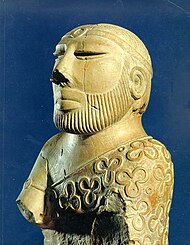| History of Pakistan |
|---|
 |
| Timeline |

Medieval history of Pakistan encompasses a significant era in the history of Pakistan or the greater Indus region, bridging the "ancient period" and the "modern period."[1] This era is generally considered to span from the advent of Islam in the 6th century CE to the early modern period, marked by the rise of the Mughal Empire in 1526. However, some historians may adjust these dates based on specific regional developments and historical perspectives. The medieval period is further divided into the early medieval and late medieval eras.[2]
In the early medieval period, the Indo-Pakistan subcontinent was home to over 40 distinct states, each characterized by diverse cultures, languages, writing systems, and religions.[3] Buddhism was predominant at the beginning of this era, with significant institutions and influence by the end of this period much of the region embraced Islam and it became the dominant religion in the region.[4][5]
The late medieval period saw a consolidation of Islamic power in the region. Many local rulers converted to Islam, leading to the establishment of prominent Islamic dynasties, including the Delhi Sultanate, which dominated the region until the early 16th century.[6] Buddhism declined during this period, but Hinduism persisted and strengthened in areas under Muslim control. The turn of the 16th century marked a significant shift with the introduction of gunpowder and the rise of the Mughal Empire. The Mughals, alongside the Ottoman Empire and Safavid Persia, were one of the major Islamic gunpowder empires.[7][8][9] The ensuing cultural and technological advancements during the Mughal era transformed society, transitioning the region from the medieval to the early modern period.
- ↑ Ahmed, Mukhtar (2014-10-25). Ancient Pakistan - An Archaeological History: Volume V: The End of the Harappan Civilization, and the Aftermath. Amazon. ISBN 978-1-4997-0982-7.
- ↑ Khan, Yar Muhammad (1996). Recent Studies in Medieval History of Indo-Pakistan Subcontinent. Institute of Secular Studies, with special arrangement from S. Chand Publisher's Distributors, Beawar, Rajasthan.
- ↑ Keay, John (2000). India: A History. Grove Press. pp. xx–xxi.
- ↑ Auer, Blain; Strauch, Ingo (2019-08-19). Encountering Buddhism and Islam in Premodern Central and South Asia. Walter de Gruyter GmbH & Co KG. ISBN 978-3-11-063168-5.
- ↑ History of Asia by B.V. Rao p.211
- ↑ Berger et al. 2016, p. 107.
- ↑ Dodgson, Marshall G.S. (2009). The Venture of Islam. Vol. 3. University of Chicago Press. p. 62. ISBN 978-0-226-34688-5.
- ↑ "Notes on the Gunpowder Empires". novaonline.nvcc.edu. Retrieved 2024-07-29.
- ↑ Streusand, Douglas E. (2011). Islamic gunpowder empires: Ottomans, Safavids, and Mughals. Boulder, Colo: Westview Press. ISBN 978-0-8133-1359-7. OCLC 191926598.
